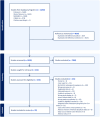Maternal and fetal outcomes in subsequent pregnancies after peripartum cardiomyopathy: A systematic review and meta-analysis
- PMID: 40308031
- PMCID: PMC12087507
- DOI: 10.1111/aogs.15117
Maternal and fetal outcomes in subsequent pregnancies after peripartum cardiomyopathy: A systematic review and meta-analysis
Abstract
Introduction: We aim to determine the pregnancy and cardiovascular outcomes of subsequent pregnancies following a previous diagnosis of peripartum cardiomyopathy.
Material and methods: Medline, Embase, CINAHL, and Web of Science were searched from inception to November 2023. Primary research studies of any design providing data for any of our outcomes of interest with greater than five subsequent pregnancies were eligible for inclusion. Primary outcomes included relapse of cardiac failure in the first subsequent pregnancy and death during any subsequent pregnancy. Secondary outcomes included a range of maternal and fetal outcomes. Proportional meta-analysis, applying a random effects model, was performed using R software.
Results: Twenty-nine studies involving 779 women were included, performed across 13 countries. The risk of relapse of cardiac failure in the first subsequent pregnancy (20 studies, 376 women) was 32%, 95% confidence interval [CI] 0.23-0.43. In those with recovered (11 studies, 123 pregnancies) and non-recovered (10 studies, 55 pregnancies) cardiac function at subsequent pregnancy outset, the risk of cardiac failure relapse was 24%, 95% CI 0.16-0.35 and 36%, 95% CI 0.24-0.50, respectively. There was a high chance of preterm birth <37 weeks (12 studies, 212 pregnancies) at 22%, 95% CI 0.17-0.29.
Conclusions: Subsequent pregnancy after peripartum cardiomyopathy presents significant maternal and fetal risks. This study provides quantification of risks to begin to fill the current evidence gap, however is limited by the paucity of existing primary research investigating this population. Robust observational studies of current practice are needed to provide answers in specific populations.
Keywords: PPCM; fetal growth restriction; heart disease; maternal mortality; obstetric medicine; preterm birth; pre‐eclampsia.
© 2025 The Author(s). Acta Obstetricia et Gynecologica Scandinavica published by John Wiley & Sons Ltd on behalf of Nordic Federation of Societies of Obstetrics and Gynecology (NFOG).
Conflict of interest statement
The authors report no conflicts of interest.
Figures







References
-
- Sliwa K, Hilfikier‐Kleiner D, Petrie MC, et al. Current state of knowledge on aetiology, diagnosis, management, and therapy of peripartum cardiomyopathy: a position statement from the heart failure association of the European Society of Cardiology Working Group on Peripartum Cardiomyopathy. Eur J Heart Fail. 2010;12:767‐778. - PubMed
Publication types
MeSH terms
LinkOut - more resources
Full Text Sources
Medical
Miscellaneous

